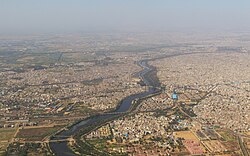| Najafgarh Drain River Sahibi (Northernmost end) | |
|---|---|
 Aerial view | |
 | |
| Location | |
| Country | India |
| City | Delhi |
| Physical characteristics | |
| Mouth | Yamuna River |
• location | Delhi, India |
| Basin features | |
| River system | Yamuna River |
| Landmarks | Najafgarh lake, Najafgarh Drain Bird Sanctuary |
| Pollution status | Highly polluted due to sewage inflow |


The Najafgarh drain or Najafgarh nalah, which also acts as Najafgarh drain bird sanctuary, is another name for the northernmost end of River Sahibi, which continues its flow through Delhi, where it is channelized, and then flows into the Yamuna. Within Delhi, due to its channelization for flood control purposes, it is now erroneously called "Najafgarh drain", and gets this name from the once famous and huge Najafgarh Jheel (lake) near the town of Najafgarh in southwest Delhi and within urbanized Delhi. [1] [2] [3] [4] [5]